
November 2023
Argentine Economy in Freefall, Brutal Austerity On the Way
Argentina Elections: Mr.
Chainsaw
vs. Washington’s Favorite Peronist
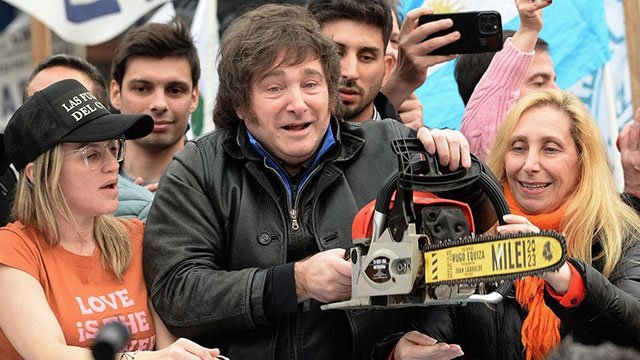
Javier Milei, the victorious far-right candidate for president of Argentina, holds a chainsaw, underlining his call for brutal cutbacks and mass layoffs of public sector workers, at a campaign rally in La Plata, 12 September 2023. (Photo: Marcos Gómez / AG La Plata)
Workers Left Front (FIT) Tailing After the Peronists
We publish below a translation of the article published by the League for the Fourth International and distributed as a supplement to El Internacionalista on the eve of the run-off round of Argentina’s presidential election. In this second-round vote, the “libertarian” Javier Milei won a decisive victory with almost 56% of the valid votes, against just over 44% for the ruling party's candidate, Sergio Massa. The victory of the far-right candidate was in large part due to the economic debacle under the Peronist government that impoverished a large part of the population, including sectors of the workers who have been the historical basis of the populist movement around the legacy of nationalist general Juan Domingo Perón. The opportunist left also has a special responsibility, for not having led a frontal class-struggle opposition against the capitalist government, thus allowing the ultra-right to channel the outrage and discontent generated by its policies.
BUENOS AIRES, November 16 – On November 19, Argentines will go to vote in run-off elections to determine who will inherit the worst economy in the region. The Argentine Central Bank’s interest rate of 133% recently placed it first in the world, while year-on-year inflation was at 143% in October. When the current Peronist regime1 of Alberto Fernandez took office at the end of 2019, the dollar was at 63 pesos. Today it hovers around 1,000 which matches the value of the largest bill in common circulation. Wallets are out and briefcases are in for any significant cash purchase. Will wheelbarrows be next? The gross domestic product for 2023 is expected to drop at least 2.5%, with the optimistic projections foreseeing at most a partial recovery of the GDP next year.
The brunt of the economic crisis has fallen on the most vulnerable sectors of the working class while the dramatic decline in purchasing power and real salaries have left none but the elite untouched. As of September, the monthly minimum salary stands at 118,000 pesos – roughly $130 dollars; in Latin America, only Venezuela’s is lower. Retirees make do with a miserable pension which is closer to $80. The average monthly salary for registered workers (excluding the vast labor black market of unregistered work) is about $450, compared to its high of $1,800 in 2017. The result is an electoral atmosphere marked by the desperation of large sectors of the population, and a feeling of disgust with the political system that could provoke a surprising outcome.
The two presidential contenders are Javier Milei, an ultra-conservative free-market economist, opposed to any state interference in the economy and an advocate of dollarization, for the Libertarian Party and the coalition La Libertad Avanza (LLA – Freedom Advancing), on the one hand, and on the other, Sergio Massa, an occasionally dissident Peronist, the candidate of “stability,” a member of the ruling Frente de Todos since 2019, minister of economy since 2022 and standard bearer of the coalition Unión por la Patria (UP). Milei has been a media phenomenon since before he burst onto the political scene in 2021, brandishing a chainsaw as a symbol of his campaign against the “political caste.” He is a supporter of former U.S. president Donald Trump and former Brazilian president Jair Bolsonaro. Massa, for his part, has met with President Joe Biden at the White House.
This dire economic state, the worst since the 2001 crisis2 and the 1975 “Rodrigazo,”3 is the product of an economy artificially propped up by extensive government spending aimed at securing votes for this election.4 Estimates of the amount spent by the government in short term aid plans aimed at buying votes are close to 2% of Argentina’s GDP. The bill for this, achieved mostly through currency swaps and other financial maneuvers, will quickly come due; along with it, there is a significant debt to the International Monetary Fund (IMF) which has been repeatedly kicked down the road. Whoever wins on November 19 will find themselves at the helm of a sky blue (the color of Argentina’ national flag) Titanic.
For the middle class, Argentina today is torn between a leap into the void with the erratic candidate of “wrath,” or the candidate of “more of the same” economic morass from which the country has been unable to escape for decades. For the working class, whoever wins, the programs of both bourgeois candidates on the ballot will result in an economic crisis even more brutal than the current escalation of prices bordering on hyperinflation. There is no alternative for the workers in the bourgeois electoral contest. It is necessary to cast a blank ballot and prepare now for a class struggle against the coming austerity.
The Electoral System
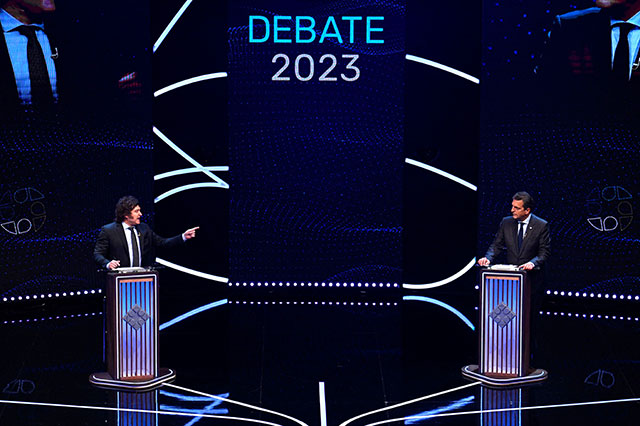
The last debate of Argentina's presidential election campaign, between Javier Milei (left) and Sergio Massa (right), on 12 November 2023. (Photo: Luis Robayo / Agence France-Presse)
Since the 2009 electoral reform, Argentina has three stages to determine the final winner in presidential contests. The first stage, the primaries or PASO (Primarias, Abiertas, Simultáneans y Obligatorias), took place on August 13 and functioned as an all-party primary. It limits access to the official debates and election funds, which under the 2010 Public Financing of Parties Law comes from the government. The general elections took place on October 17 and given that no candidate achieved an overwhelming victory (45%+), the final runoff takes place this coming Sunday, November 19.
In the primary elections, Milei won a noteworthy victory with 31% of voters choosing him, raising expectations that he could sweep the general election without having to go through a runoff vote. Instead, Massa came in third with just 21% of direct votes for him. The traditional right-wing party, Cambiemos, which put Mauricio Macri in the presidential chair in 2015, now expanded and rebaptized as Juntos por el Cambio (JxC – Together for Change), had a primary split between the current mayor of Buenos Aires, Horacio Rodríguez Larreta, a reputed moderate, and the hard right-winger Patricia Bullrich, the former minister of social security. Bullrich came out ahead, but Cambiemos found itself eclipsed by Milei.
The October 22 general elections turned into an unusual three-way race between Peronism, supporting the official candidate of the current government, Massa; Bullrich, backed by supporters of Macri and the classical right wing; and the “libertarian” Milei, who defines himself as “anarcho-capitalist” (AnCap). Massa was able to overcome the disastrous performance in the primaries by marshaling the full power of Argentina’s executive and relying on the local Peronist party machines. He was helped by Bullrich’s pathetic debate performance and Milei’s own insistence on defending his most absurd and fantastical conservative proposals (including a free market for human organs and doing away with the right to abortion, which was won at the end of 2019 after a long struggle).5
Massa came out ahead with 36% to Milei’s 30% and is now considered the likely front-runner to win in the runoffs. However, if all the voters for the anti-Peronist slates were to unite, as has often been the case in the past, they could achieve a majority of the votes. Taking into account that mathematical possibility, and the support for Milei from Bullrich, Macri and others of the hard right, the numbers in recent polls (notoriously unreliable in Argentina) point to a close race and it can not be excluded that Milei, who is now moderating his message, could manage to come out ahead ultimately.
Massa, Best Friend Forever of the White House
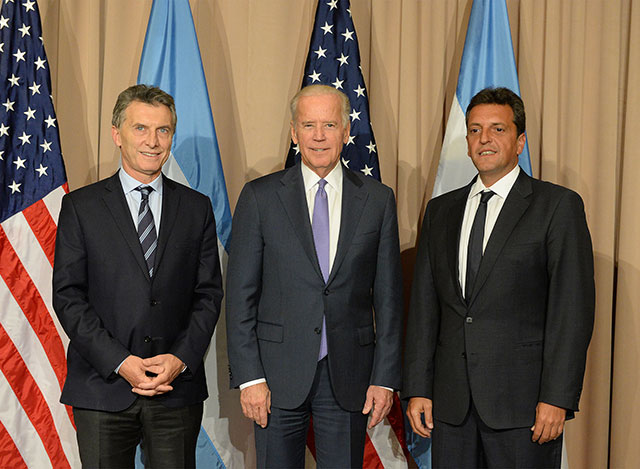
Sergio Massa (right) and Argentina's then-president Mauricio Macri (left) together with U.S. vice president, now president, Joe Biden, at the summit of the world's top leaders and power brokers in Davos, Switzerland, January 2016. Massa, the former "renovator" is now the official candidate of the Peronist slate Union for the Homeland, and a best friend forever of whoever resides in the White House (he also had good relations with Donald Trump).
(Photo: Casa Rosada)
With a disastrous economic performance behind him, re-election for current president Alberto Fernandez was out of the question. The wing of Peronism most closely tied to former president Cristina Kirchner initially floated candidates more loyal to Kirchnerism.6 But the only truly universal value in Peronism is the ability to win. Capitalist interests made it clear that any chance of success required accepting the leadership of the party’s right wing. So the choice fell on Massa, who left the PJ in 2013 to found the Frente Renovador, ran for president in 2015 and initially collaborated with the victor Macri. He then returned to the bosom of Peronism as president of the Chamber of Deputies and later as economy minister, billed as a “super-minister” for the sole purpose of winning the elections.
Massa represents a pragmatic compromise, both for Peronism and for the spokesmen of Argentine big business. The ex-president (Cristina Kirchner) is still worried about potential judicial investigations into corruption charges. The deal offered to the local and international bourgeoisie is fairly simple: Peronism adopts a conservative economic program and guarantees social stability for its implementation; in exchange, any inconvenient investigations remain blocked and the key clientelist networks of the ruling party remain intact. Given the alternative: a potential mobilization of those networks and the broader unemployed movement against an unstable and inexperienced fanatic (Milei), Massa has been attractive enough to win over organs of the international bourgeoisie like the Financial Times, which described Massa in an October 23 article as “a pragmatist who is already wooing support from centrists in Bullrich’s coalition, and he is the best placed to build a political consensus around reform.”
This is a fairly accurate evaluation, to which should be added the Peronist’s extremely cozy relationship with the U.S. Embassy. Massa managed the impressive feat of being invited both to the 2016 Democratic national Convention nomination of Hillary Clinton and to the 2017 inauguration of President Trump. Massa was one of the few Peronists to take seriously the claim of [the U.S. puppet] Juan Guaidó to be the legitimate government of Venezuela. Recently he backed away from Argentina’s timid condemnation of Israel’s genocidal bombardment of Gaza, instead reposting a social media message emphasizing “the absolute right of Israel to self-defense.” Biden could hardly ask for a better accomplice.
Milei, “General AnCap”

Javier Milei, as General AnCap (anarcho-capitalist), in December 2019. (Photo: Clarín)
The mainstream (bourgeois) press tends to mock Javier Milei, who is always accompanied by his sister Karina, the tarot card seer he calls “The Boss” and the “Moses” of his candidacy; who communicates, so he says, with his deceased dog Conan, which he had cloned. At first, Milei was promoted on television in order to shift political discourse to the right. His dramatic appearances range from wielding chainsaws, demanding huge budget cuts and massive layoffs, to appearing at an anime cosplay convention as “General AnCap.” The “superhero” version of Milei claimed that his mission was to “kick the crap out of Keynesians and collectivist SOBs who want to screw up our lives.”
Milei’s broadsides against the political “caste” and his central proposal of dollarization of the economy have struck a chord among wide sectors of the impoverished petty-bourgeoisie but also among significant sectors of the working class. Argentina’s skyrocketing inflation rate has made saving for a car or motorcycle almost impossible, not to mention lofty dreams like home ownership. The working class has seen its living conditions eviscerated not so much through frontal attacks by their capitalist employers so much as by the deliberate inflationary policy of the Peronist government. It is no surprise then that significant sectors have identified that state as the principal culprit of their distressed and have been seduced by the “anarcho-capitalist” provocations of Milei.
The appeal of Milei, however, is only partly connected to his economic program or ideology. Generally speaking, the more he explains himself – whether on his negation of global warming, his negationism about the total number of victims of the dictatorship, his call for a free market for human organs and the adoption of babies – the less support he gets. While his most diehard supporters may believe in some version of his ultra-liberal (free market) ideology, the vast majority of his voters see his candidacy as an opportunity to toss a bombshell into Argentina’s rotten political structure.
The political phenomenon of the “libertarian” Milei was fueled by ultra-rightist sectors of the bourgeoisie to rein in the Peronists’ populist policies, which they consider too costly. But if his economic program were to be implemented it would lead to the liquidation of big sectors of Argentina’s own bourgeoisie. A free market would wipe out most of Argentina’s industry which depends on direct or indirect government subsidies that are extracted in one way or another from the productive sectors of agribusiness. A tiny handful of agribusiness magnates would be left facing millions of unemployed workers alongside millions of bankrupted petty-bourgeois in a country with a relatively weak repressive apparatus. No mathematical genius is required to see how that could turn out.
Milei’s ideological crusade has also led him to call to break commercial relations with China and Brazil, Argentina’s largest markets who even the most aggressively anti-Peronist CEO is eager to keep pleased. Not even the brutal military dictatorship of Rafael Videla let ideology get in the way of agribusiness profits that came from shipping grain to the USSR.
So it is easy to understand how not only the Peronist party apparatus but significant sectors of the bourgeoisie – represented by most of the major media channels – turned, if not directly against Milei, at least in favor of clipping his wings. They simply promoted Milei a bit less, and baited him into restating many of his previous statements, in which he insulted Argentine pope Francis and soccer star Maradona (the latter by far the holiest in the eyes of many Argentinians). After his setback in the October general elections Milei is no longer in a position of strength and has had to embrace the whole anti-Peronist political spectrum. The result is that the roar of the “Lion” as his supporters call him, has been toned down, and he is back to performing tricks for a circus run by the elder statesmen of political power.
Argentine Fascism?
Despite hysteria from Peronist and left sectors Milei is no fascist; his proclivities are rather in the bonapartist direction. He would no doubt have been thrilled to be part of a team of advisors for military dictators, like the Chicago Boys for Pinochet in Chile or Videla in Argentina. His vice-presidential candidate Virginia Villaruel, one of many adventurers riding the coattails of his popularity, is a signer of the Madrid Charter orchestrated by the Spanish neo-Francoist Vox party and she has ties to ex-military leaders who were jailed. Milei has received the support of Bolsonaro in Brazil, whose son Eduardo (linked to the militias responsible for the assassination of Marielle Franco in 20187) campaigned for Milei.
The Argentine military dictatorship from 1976 to 1983 committed the worst crimes and ultimately had the most discredited end of the military regimes in the region (the lost war for the Falklands/Malvinas Islands that led to the overthrow of the junta). Argentina was the only country to imprison wide sectors of the military regime and has ever since maintained a comparatively weak army (half of Chile’s budget with double the population). Years later, unbridled repression by the police helped turn the economic crisis of 2001 into the political crisis that saw right-wing president De la Rua of the UCR flee the country in a helicopter. The political regime subsequently installed by Nestor Kirchner, and after his death in 2007 by his wife Cristina, oversaw a certain stabilization through co-optation and clientelism, achieving “governability” by doling out social benefits and subsidies. This was acceptable to the bourgeoisie in the period of economic growth brought on by the commodities boom of 2000-2014. Today the situation is very different.
During the presidencies of the Kirchners, tensions were deepening between the government and rural producers. Macri’s victory in 2015 saw an unsuccessful attempt by the right to finance a soft exit from this regime, by taking on significant foreign debt. However, Peronism in opposition was willing to confront Macri’s reforms in the streets and the hoped-for shower of foreign investment never materialized (investors correctly figured Macri’s rule would only be an interlude). Peronism’s power base and clientelist networks remained largely intact and it was able to easily vault itself once more to power in 2019. However, the fundamental economic sickness plaguing Argentina continued and worsened dramatically with the COVID-19 pandemic. The result was the debacle of the current government’s inflationary economic stagnation (stagflation).
In this context, the ambition of the right wing and substantial sectors of the capitalist class in Argentina is not to establish a bonapartist or military regime of the right, both rather to shake off their costly dependency on the populist policies of the Peronist regime and to strengthen the repressive capacity of Argentina’s bourgeois state. In the debates, this was clearly expressed in the calls for law and order by the candidate of the traditional right wing, Patricia Bullrich, but it could also be carried out by a government of the Peronist Massa. He has committed himself to forming a “government of national unity,” including figures from Bullrich’s JxC and even from Milei’s LLA. Massa also promised to “put order” in the state’s finances, to restore fiscal balance and accumulate foreign exchange reserves. And as a guarantee of his commitment, in the debates Massa proclaimed his intention to create an “Argentine FBI,” that is, a powerful political police force to keep potential “troublemakers” at bay.
What’s at stake in these elections is not social democracy vs. “libertarian” economics, much less democracy vs. fascism. The real crux of the dispute is to what extent the Peronists will be removed or incorporated into the “reform” process, and the price the bourgeoisie is willing to pay for their collaboration.
The Left Front Faces the Acid Test
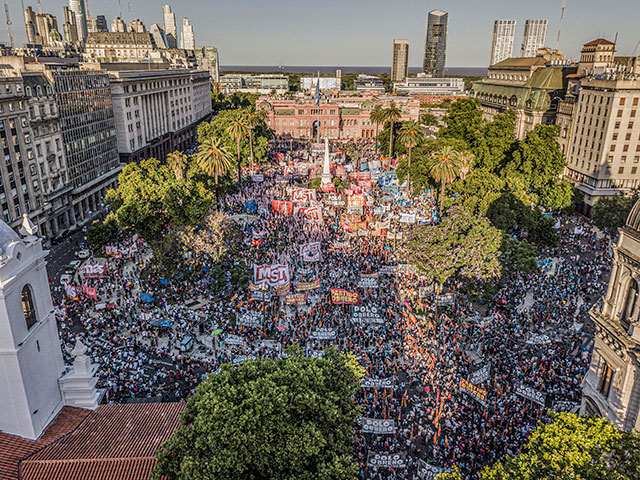
A mega-mobilization of the FIT-U parties and related piquetero groups fills the Plaza de Mayo, 11 December 2021, to protest the deal being negotiated with the International Monetary Fund. The working class must also mobilize against the Peronist government, whose inflationary policy in the service of the Argentine bosses is overwhelming the working people, while a new “adjustment” (austerity package) cooked up with the IMF is on the drawing board. (Photo: Prensa Obrera)
The current electoral contest represents a litmus test for the United Left and Workers Front (FIT-U). Since its founding 12 years ago, the FIT has been an electoral cartel made up of centrist and reformist pseudo-Trotskyist groups around a lowest-common-denominator program.8 Its justification for this opportunist creation is that it is supposed to represent “class independence” with respect to the bourgeois political formations. Now we see its true face.
Argentine pseudo-Trotskyism was born with the publication by Nahuel Moreno of the newspaper Palabra Obrera “under the discipline of General Perón,” after the latter was overthrown in 1955 by a military coup plotted by U.S. imperialism and the Catholic hierarchy. Moreno had already three years earlier abandoned his prior opposition to the government of the bourgeois nationalist general, and considered himself as “a ‘de facto’ part of the anti-Yankee front of Peronism.”9 Subsequently, Moreno and followers went through different phases in which they posed as Guevarist guerrillas, Chinese Red Guards, Sandinista fighters decked out in olive green and even Iranian Islamist “revolutionaries,” ending up as well-behaved Argentine social democrats. Now, in the 2023 elections, the various ex- and neo-Morenoites have come full circle by accepting – more or less explicitly, depending on the particular grouping – their role as a left pressure group on Peronism.
In 2015, facing a second round of elections very similar to the current one, between the Peronist Daniel Scioli and the right-wing candidate Mauricio Macri, the FIT, despite its opportunist appetites, rightly called to cast a blank ballot and actively campaigned for this among its constituents and the working class in general. This infuriated petty-bourgeois “progressive” opinion, which regarded the FIT as acting as saboteurs who prevented the Peronist victory. In 2019 there was no second round, so the parties of the FIT were able to duck the issue. Today in the contest between Milei and Massa (who makes Scioli look like a leftist), the FIT-U parties have capitulated and refuse to campaign in the working class in favor of a blank ballot.
The FIT-U has four main components. The PTS (Socialist Workers Party, internationally part of the Trotskyist Fraction), whose presidential candidate Myriam Bregman was the face of the FIT’s electoral campaign, is in the lead position. There are also the PO (Workers Party), the second largest force; the MST (Socialist Workers Movement), affiliated with the LIS (International Socialist League); and the I.S. (Izquierda Socialista, Socialist Left), part of the UIT (International Workers Unity) tendency.
Izquierda Socialista has opted for the most explicit position, “calling for a critical vote for Massa.”1 The I.S. pretends that this does not imply “any political support,” which is an absurdity, since voting for a candidate or a slate is the quintessence of political support. It cites as a precedent the FIT’s call in 2018 to vote for Fernando Haddad, of the bourgeois popular front around the Brazilian Partido dos Trabalhadores (PT – Workers Party), against Bolsonaro. Their shameless opportunism has been rewarded with a laudatory article in Página12, the house organ of the “progressive” Kirchnerists who, of course, are thrilled with the capitulation. If the remaining parties of the FIT-U were to claim even a semblance of formal class independence, they would have to expel the I.S. from the FIT-U. Naturally they do nothing of the sort.
The same operation is being carried out by the MST, calling on “workers and young people NOT to vote for Milei and his reactionary, anti-human-rights and negationist project, which must be stopped.”11 The MST then makes explicit its refusal to call for a blank ballot. It says that “we understand the democratic will of those who voted for Massa in order that Milei not win, hence we will not call for a blank ballot nor will we campaign in that sense.” The MST also pretends that with its position, as cowardly as it is incoherent, they do not give political support to Massa. Again, this is absurd. With this wink they are giving their tacit approval to vote for the Peronist, they just don't want to take the responsibility. For this they will need a lot of hand sanitizer.
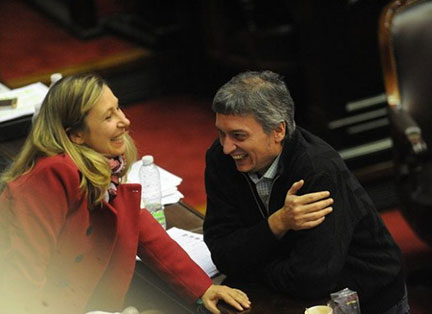 Myriam Bregman of the PTS, the
presidential candidate of the Left and Workers Front - Unity
in the 2023 elections, with Máximo Kirchner the billionaire
son of former president Cristina Kirchner, February 2022.
The FIT has accepted its role as a left-wing pressure group
on Peronism.
Myriam Bregman of the PTS, the
presidential candidate of the Left and Workers Front - Unity
in the 2023 elections, with Máximo Kirchner the billionaire
son of former president Cristina Kirchner, February 2022.
The FIT has accepted its role as a left-wing pressure group
on Peronism. (Photo : Negocios&Política)
As for the PTS, the first comment came from its candidate Bregman, who with her 722,000 votes (2.7 percent of the total) in the general elections challenged the left to define itself in the runoff. Her contribution was to affirm that Sergio Massa and Javier Milei “are not the same” (La Nación, 23 October). In its official communiqué,12 which arrived a week later, after opining that “millions will surely again use their vote to prevent an eventual victory of the ultra-reactionary Milei,” and saying that “we understand this attitude,” the PTS expresses its regret that, “While of course we do not call for a vote for Milei, however, coming from the left we cannot give any kind of political or electoral support to Massa.” A sentence full of regret and guilt for not having been able to offer support to Massa. What a pity!
Compare this with the statement of the presidential candidate of the PTS, Nicolás Del Caño, the day after the 2015 elections: “in line with what we said in our campaign, we are going to call for a blank ballot and not to support either of the two candidates.”13 Why is there no call for a blank ballot campaign as in 2015? What has changed? No answer will be found in the statements of the PTS. They devote space in their press to such vital issues for the proletariat as the anniversary of singer Shakira’s album, “Bruta, ciega, sordomuda: a 25 años de ‘¿Dónde están los ladrones?’” (Blind, Deaf and Dumb: 25 years after ‘Where Are the Thieves’”), Izquierda Diario, 29 September. But as for an explanation of the sharp turns to the right of its own policy, so that its supporters are not left “blind, deaf and dumb” in the face of the refusal of the PTS and the FIT to campaign against the favored candidate of big business and imperialism for the presidency of Argentina, not a word.
The fourth component of the FIT-U, the Partido Obrero (PO), represents another, centrist, strand of Argentine pseudo-Trotskyism, dating back to the 1960s, associated with founding leader Jorge Altamira, who was for decades Moreno’s competitor. Several weeks after the elections PO announced the conclusion of its electoral conference, declaring that it will not vote for Milei or Massa, and ... that’s it, nothing more.14 Although some in the bourgeois press have interpreted this as a veiled call to cast a blank ballot, in reality PO has not issued any watchword for the runoff election. Why? Because they are “aware that a part of the left-wing electorate is geared up to vote for Massa,” and although it affirms that PO will not vote for the Peronist candidate, it does not want to confront that mass of workers (and possibly be blamed for an eventual Milei victory at the ballot box) by campaigning for a blank or null vote.
What's interesting in their statement is that they take the trouble to explain their betrayals of class independence on an international scale, defending their votes for Gabriel Boric in Chile, Pedro Castillo in Peru, Gustavo Petro in Colombia and Evo Morales and the MAS in Bolivia, all of them bourgeois politicians and parties. They, too, cite their vote for Haddad in Brazil in 2018, under the pretext of the feminist mobilization “Ele não” (Not him) against Bolsonaro. (In Argentina the feminist movement is largely controlled by Peronists.) Perhaps if the “Swifties against Milei”15 phenomenon assumes mass proportions, PO would be tempted to call for a vote for Massa. In each instance, they stress that the determining factor of their vote is the existence, or not, of large mobilizations in favor of, or illusions in, the candidate in question. In other words, instead of swimming against the current and telling the truth to the masses, they splash around in the wake of petty-bourgeois and bourgeois popular movements.
What we are seeing in the FIT-U is a “sliding scale of opportunism.” The I.S. openly calls to vote for the candidate of the big bourgeoisie and imperialism, Sergio Massa; the MST says it will not vote for Massa, but neither does it advocate a blank ballot that could prevent his victory; the PTS does not call to vote for Massa, but “understands” those who will and therefore does not call not to vote for him; and PO “understands” that the masses will vote for Massa, and consequently does not issue a slogan of what to do in the second round of the presidential elections. According to polls, it is estimated that 77 percent of those who voted for the FIT-U candidate in the general elections will vote for Massa in the runoff. Where, then, are the urgent warnings that voting for the Peronist candidate would pave the way for a new, and more brutal, “ajuste” (adjustment, i.e., austerity program) dictated by the IMF, which is surely already prepared? Or how about once favorite slogans of Morenoism, such as “Worker: don't vote for the exploiter.” There are none.
It’s a fact: not one of the components of the Left and Workers Front is calling for, much less actively campaigning for, a blank ballot in the second round of the presidential elections. This deafening silence underlines that the “unity” of this electoral cartel is that of multiple shades of opportunism. It is animated by the same “fight the right” politics that led the vast majority of the U.S. “socialist” left to advocate, directly or indirectly, voting for Democrat Biden against the ultra-right Republican Trump. In fact, PO supported, at the height of the U.S. election campaign, the slogan “Trump out.” Even the terminology of “left” and “right” comes from bourgeois politics, not Marxism, which is based on the counterposed class interests of the proletariat and the capitalist ruling class.
The FIT-U, in order to hold onto the “progressive” votes that help keep its handful of parliamentary seats, hands the working class to the class enemy on a silver platter. We of the League for the Fourth International insist that genuine Trotskyists never vote for any bourgeois candidate, party or coalition. We fight invariably and unswervingly for class independence and for communist, revolutionary and internationalist politics.
In the Argentine Runoff Election: Cast a Blank Ballot, and Prepare the Workers Offensive Against Austerity
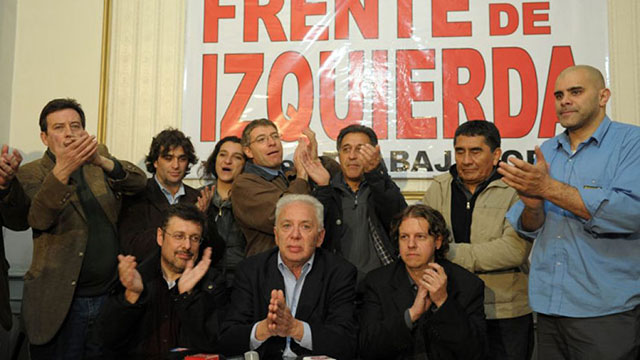
At the founding of the Frente de Izquierda y de Trabajadores (FIT) Jorge Altamira (center), then leader of the Partido Obrero; Christian Castillo (seated on the right) of the Partido de Trabajadores Socialistas; and Gabriel Solano (second from the left), current leader of PO, in August 2011. (Photo: CEDOC)
To the left of the FIT, the most significant organization is Política Obrera (Workers Politics), under the leadership of the former leader of the official PO, Jorge Altamira, who after a 2019 split took up the original name of the current he founded. Política Obrera correctly calls for a blank ballot, has refused to vote for the FIT in recent elections and has criticized the right-wing drift of the FIT-U. However, it shouldn't be forgotten that it was Altamira himself, when he headed the PO, who put together the unprincipled electoral propaganda bloc that is the FIT. A 2011 book by Altamira (El ascenso de la izquierda [The Rise of the Left]) glorifies the FIT. Jorge Altamira was the first presidential candidate of the FIT, he was elected state deputy on its slate, and only broke with it when the party apparatus he built turned against him.
Altamira himself had no qualms about calling to vote for Haddad in 2018 and for Lula in 2022 with justifications identical to those wielded by sectors of the FIT-U in their embrace of Massa:
“In the framework of this situation, a vote for Lula is posed; the contrary would be to argue for a position equidistant between the pseudo-left together with the liberal right, on the one hand, and the fascist right, on the other. In 2018, when Lula was banned, we called to vote for Fernando Haddad against Bolsonaro. Electoral support to a candidate alien to socialism and to the historic interests of the working class does not mean, in any way, political support to his policies – it is, on the contrary, the way to uphold the irreconcilable hostility of socialism against a fascist outcome. To cast a blank or null vote is to shut oneself up in self-proclamation.”16
The insistence of the founder of the PO and the FIT that “Voting for a given candidate is not political support, but an alternative imposed by concrete circumstances,” is utter hypocrisy, a sleight of hand to try to hide his own responsibility. To vote for a candidate is precisely to give them political support (unlike military support to one side in a war), and leftists who vote for a bourgeois candidate, party, coalition or electoral list are responsible for the future action of the same once they come to power (with the help of said leftists). The Leninist tactic of critical support for a candidate of a working-class political formation serves to draw the class line, not as an excuse to cross it.
The disputes between Altamiristas and Morenoites in Argentina go back decades. They have a relationship of feuding twins, in which Altamira inclined to centrist positions, slightly to the left, while Moreno in his later years leaned more to reformism, although both had engaged, at one time or another, in similar opportunist practices. In the 1970s, the two competed in a game of one-upmanship, proposing to each other workers fronts, worker and people’s fronts, anti-imperialist fronts, revolutionary anti-imperialist fronts, and the like. More recently the pattern is being repeated in the polemics in and around the FIT. Being very erudite in matters of pseudo-Trotskyism, they frequently engage in a war of quotations from Marx, Engels, Lenin and Trotsky. And when the PTS responds to an apt criticism of its current policy by Altamira, all it has to do is cite the latter's writings of a decade ago when he proclaimed the very policy that he lashes out at today.
What is missing in these exchanges, and what is needed, is a principled policy and consistent record based on the Leninist and Trotskyist revolutionary program.
In the present case, the call for a blank ballot in a contest between two bourgeois forces, to fight for the political independence of the workers from their class enemies, is only a first step to resist the capitalist offensive that will be unleashed the day after the elections. It is urgent, starting now, to begin to forge the instruments for the necessary proletarian counteroffensive. Morenoites of all stripes (traditional, ex or neo) are always calling on the trade-union leaderships to draw up a “plan of struggle” against this and that. We Trotskyists fight within the unions against the leaderships that have sold out to the bosses, on the basis of a transitional program pointing to socialist revolution. However, we do not pretend that organizations tightly controlled by Peronist bureaucrats, who today are calling for a vote for Massa, will lead a fight for a sliding scale of wages and working hours, for workers self-defense groups, etc. Winning such struggles requires the ouster of this pro-capitalist bureaucracy.
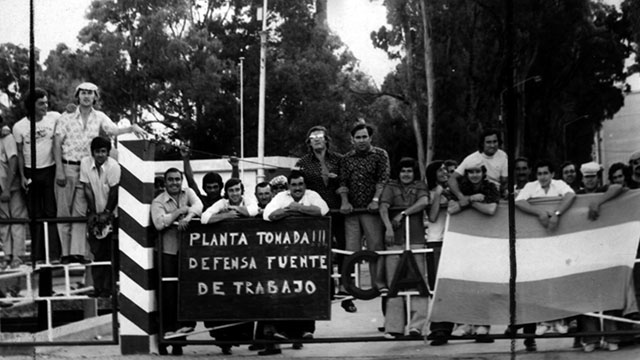
In June-July 1975, workers of the inter-worker coordinating committees in the Northern Zone and other parts of Greater Buenos Aires (above) occupied factories and mobilized massively, breaking the grip of the Peronist trade-union bureaucracy and defeating the austerity plan (the Rodrigazo) of Isabel Perón's government. Faced with the current elections between two candidates of the bourgeoisie, both committed to policies to "clean up" the capitalist economy at the expense of the workers, it is urgent to initiate the organisms for a proletarian counteroffensive. (Foto: Razón y Revolución)
It is necessary to break with the bourgeois parties and launch a campaign to resurrect the historic instruments of working-class resistance. It was the emergence of the inter-factory coordinating committees, first in the Zona Norte and then in the rest of Greater Buenos Aires, which was able to mobilize the working class to break with the Peronist bureaucracy and bury the austerity drive of the 1975 rodrigazo. Such councils may only bring together a small minority of workers at first, but they would allow the vanguard to lead the struggle against the capitalist onslaught that is barreling down on us. They could also provide a framework for incorporating the unemployed movements – for example, the piqueteros17 – linking them to the power of the industrial proletariat.
In the face of the deep economic crisis confronting the workers and oppressed of Argentina, the fake-socialist, democratizing left of the FIT-U has only offered an electoral response, even when the choice is between two capitalist and notoriously anti-working-class candidates. Argentina's electoral reform and the financing of candidacies of leftist groups have turned out to be good business for the bourgeoisie, keeping potential troublemakers confined to the safe channels of parliamentarism and infected with rampant parliamentary cretinism. This lets the union bureaucracy off the hook that has organized the repression of union activists, like the 2010 murder of Partido Obrero militant Mariano Ferreyra. The reformist and centrist currents continue to gyrate on the electoral merry-go-round as the circus music fades away and is replaced by the thundering trumpets and the booming drums of the Peronist March.
The Argentine elections are taking place in an international context marked by the U.S.-Israel war against the Palestinian people. With U.S.-made bombs dropped from fighter-bombers supplied by the Pentagon, what does the Argentine left do? It asks the Peronist government to break relations with Israel and gives a nod of approval to those who vote for the Peronist candidate of the U.S. embassy who supports this campaign of extermination in the name of defense of the Zionist state. And let's not forget how in 2020 PTS and PO legislators voted for a definition of anti-Semitism that equated it to criticism of Israel's policy in a new annexationist expansion in the West Bank. Although the FIT later repudiated its vote, it’s explanation was that it was part of a block of measures adopted without discussion. Welcome to the parliamentary circus!
The ferocity of the economic crisis facing Argentina demands a class-struggle response, organized by a revolutionary communist leadership, built in the struggle to reforge an authentically Leninist and Trotskyist Fourth International. We invite those interested in rediscovering the genuine Trotskyist tradition and program to join us in this urgent task. ■
- 1. Since the time of the governments of General Juan Domingo Perón (from 1946 until his overthrow in 1955, and again from October 1973 until his death on 1 July 1974) the Argentine political scene has been dominated by la grieta (“the rift”) between the bourgeois populist movement of Peronism, under the label of the Partido Justicialista (PJ), with strong roots among the workers; and the anti-Peronism of the traditional right wing of the bourgeois elite headed by the Unión Cívica Radical (UCR), and more recently by the electoral coalition Cambiemos (Let’s Change), of which the UCR is one of the pillars.
- 2. See “Mass Upheaval Rocks Argentina, Brazilian Workers Movement Under Attack” (January 2022), in The Internationalist No. 13, May-June 2002. n° 2, mayo de 2022.
- 3.In June 1975, Economy Minister Celestino Rodrigo of Isabel Perón's government decreed an economic “shock therapy” program, sharply devaluing the Argentine peso while raising transportation and gasoline prices. Instead of taming runaway inflation, it led to a decade and a half of inflation rates in excess of 100% per year.
- 4. Between public sector jobs, subsidies and social programs, it is estimated that more than 50% of Argentina's working population depends on the state for its livelihood. See “La grieta y la motosierra,” Tal Cual (Venezuela), 12 November.
- 5. See “The Struggle for Full Abortion Rights, From Latin America to the U.S.,” The Internationalist No. 66, January-April 2022.
- 6. The grouping known as La Cámpora (after former Peronist president Héctor José Cámpora), led by Máximo Kirchner, son of former presidents Nestor Kircher and Cristina Fernández de Kirchner, is a continuation of the Peronist Youth whose antecedents go back to the Montonero guerrillas of the 1970s. In the labyrinthian politics of Peronism, Kirchnerism represents a centrist current between the more “progressive” wing (Patria Grande) and the right-wing supporters of ex-president Carlos Menem. Having campaigned against Menem’s “neo-liberal” policies dictated by the International Monetary Fund and opposing free-trade agreements with the U.S., the Kirchners in office used state intervention to impose austerity policies not that different from those of the IMF.
- 7.See “Racist Execution in Rio,” The Internationalist No. 51, March-April 2018
- 8. The League for the Fourth International has characterized the FIT-U as an unprincipled propaganda bloc with a deeply reformist electoral practice, and as such we have opposed giving even a critical vote to its candidates. See “The Left Front in Argentina: A Reformist Electoral Cartel” (October 2018), in The Internationalist No. 55, Winter 2019).
- 9. See the pamphlet Moreno Truth Kit, published by the international Spartacist tendency in January 1980.
- 10. “Llamamos a votar contra el ultraderechista Milei”, Izquierda Socialista, 7 November.
- 11. “Balotaje con final Abierto” and “Hacia el balotaje y después, Nuestra política y tareas”, Alternativa Socialista, 8 November.
- 12. “Posición del PTS frente a la situación política nacional y el balotaje”, Izquierda Diario, 30 October.
- 13. “Para Del Caño “primó el voto útil” y el FIT llamará a votar en blanco en el balotaje”, Izquierda Diario, 26 October 2015.
- 14. “No apoyamos políticamente ni votamos a Milei ni a Massa”, Prensa Obrera, 4 November.
- 15. Pop singer Taylor Swift's latest mega-concert, on November 11, coincided with the last Milei-Massa debate, and was accompanied by a deluge of flyers and posters with the message, “Swifties don't vote for Milei.”
- 16. Jorge Altamira, “El voto por Lula”, Política Obrera, 13 October 2022. In sharp contrast, read the position of our comrades of the Liga Quarta-Internacionalista do Brasil “In the Elections: Vote No, Neither Bolsonaro, Nor Lula/Alckmin; In the Streets: Class Struggle of the Workers and Oppressed to Crush the Coup Danger and Fascistic Forces,” in “Brazil: “Broad Front” Blocks Workers Mobilization Against Militarist Threat,” The Internationalist No. 67-68, May-October 2022.
- 17. Beginning in the late 1990s as many factories in Argentine closed due to the policies of the Peronist government of Carlos Menem – who pegged the Argentine peso to the U.S. dollar, making many Argentine industries uncompetitive internationally and leading to mass layoffs – movements of unemployed workers arose that blocked highways with pickets (piquetes). This intensified with the economic crisis of 2001-02 that saw a huge increase in unemployment, and since then piquetero movements of thousands of jobless workers have persisted, some controlled by the Peronist bureaucracy and others led by leftists, all competing for government financing.
